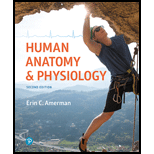
Pearson eText Human Anatomy & Physiology -- Instant Access (Pearson+)
2nd Edition
ISBN: 9780136873822
Author: Erin Amerman
Publisher: PEARSON+
expand_more
expand_more
format_list_bulleted
Concept explainers
Question
Chapter 18.7, Problem 6QC
Summary Introduction
To review:
The process of blood circulation through the hepatic portal system. Functions of the hepatic portal system.
Introduction:
The hepatic portal system comprises the hepatic portal veins and its tributaries. The splenic, gastric, and inferior and mesenteric veins merge with the hepatic portal vein and enter the liver. This system is responsible for carrying blood from different parts of the gastrointestinal tract (GIT) to the liver.
Expert Solution & Answer
Want to see the full answer?
Check out a sample textbook solution
Chapter 18 Solutions
Pearson eText Human Anatomy & Physiology -- Instant Access (Pearson+)
Ch. 18.1 - Define the three types of blood vessels in the...Ch. 18.1 - Prob. 2QCCh. 18.1 - Prob. 3QCCh. 18.1 - Prob. 4QCCh. 18.1 - Prob. 5QCCh. 18.1 - 6. How do veins differ structurally and...Ch. 18.1 - Prob. 7QCCh. 18.1 - What are venous valves, and what are their...Ch. 18.1 - Prob. 9QCCh. 18.2 - Prob. 1QC
Ch. 18.2 - Prob. 2QCCh. 18.2 - Prob. 3QCCh. 18.2 - Prob. 4QCCh. 18.2 - Prob. 5QCCh. 18.2 - Prob. 6QCCh. 18.2 - 7. How does mean arterial pressure differ from...Ch. 18.2 - Prob. 8QCCh. 18.2 - Prob. 9QCCh. 18.3 - Prob. 1QCCh. 18.3 - Prob. 2QCCh. 18.3 - Prob. 3QCCh. 18.3 - Prob. 4QCCh. 18.3 - Prob. 5QCCh. 18.3 - Prob. 6QCCh. 18.3 - Prob. 7QCCh. 18.3 - 8. What is circulatory shock, and why is it...Ch. 18.4 - Describe the structure and size of a typical...Ch. 18.4 - 2. List three ways in which substances may cross...Ch. 18.4 - 3. Describe the properties of the three types of...Ch. 18.4 - 4. What is tissue perfusion?
Ch. 18.4 - Prob. 5QCCh. 18.4 - Prob. 6QCCh. 18.4 - Prob. 7QCCh. 18.4 - Prob. 8QCCh. 18.4 - Prob. 9QCCh. 18.5 - What is hydrostatic pressure? How does hydrostatic...Ch. 18.5 - 2. In which direction does the hydrostatic...Ch. 18.5 - 3. What is colloid osmotic pressure? In which...Ch. 18.5 - Prob. 4QCCh. 18.5 - Where in the capillary does net filtration take...Ch. 18.5 - Prob. 6QCCh. 18.6 - List the three branches of the aortic arch.Ch. 18.6 - Prob. 2QCCh. 18.6 - 3. What is the cerebral arterial circle, and what...Ch. 18.6 - Prob. 4QCCh. 18.6 - Which arteries supply the anterior and posterior...Ch. 18.6 - Prob. 6QCCh. 18.6 - Which artery supplies the upper limb?Ch. 18.6 - Trace the arterial supply of the upper limb from...Ch. 18.6 - 9. Which artery supplies the lower limb?
Ch. 18.6 - Trace the arterial supply of the lower limb from...Ch. 18.6 - Prob. 11QCCh. 18.7 - Where do most veins superior to the diaphragm...Ch. 18.7 - Prob. 2QCCh. 18.7 - Where are the dural sinuses located? What drains...Ch. 18.7 - How does drainage of the posterior body wall...Ch. 18.7 - 5. Which abdominal vessels drain straight into...Ch. 18.7 - Prob. 6QCCh. 18.7 - Prob. 7QCCh. 18.7 - Prob. 8QCCh. 18.7 - Prob. 9QCCh. 18.7 - Prob. 10QCCh. 18 - Prob. 1CYRCh. 18 - Locations where vessels connect via collateral...Ch. 18 - 3. The carotid sinus contains:
a....Ch. 18 - 4. Which of the following factors would increase...Ch. 18 - Which of the following would produce a decrease in...Ch. 18 - Fill in the blanks: The two pressures within the...Ch. 18 - The lowest pressure in the systemic circuit occurs...Ch. 18 - Explain the mechanisms that assist in the return...Ch. 18 - Mark the following statements as true or false. If...Ch. 18 - Prob. 10CYRCh. 18 - Capillaries consist of: a. three thin tunics. b....Ch. 18 - List three ways in which substances can cross the...Ch. 18 - Which of the following structures is the leakiest?...Ch. 18 - Prob. 14CYRCh. 18 - 15. The hydrostatic pressure gradient drives water...Ch. 18 - Prob. 16CYRCh. 18 - Match the following arteries with the correct...Ch. 18 - Which of the following is not a common pulse...Ch. 18 - 19. Which of the following vessels does not drain...Ch. 18 - Match the following veins with the correct...Ch. 18 - 1. Explain why a severed artery spurts blood,...Ch. 18 - 2. Explain why a person who is 7 feet tall is...Ch. 18 - Prob. 3CYUCh. 18 - Prob. 1AYKACh. 18 - 2. Mr. Gupta has been diagnosed with nephrotic...Ch. 18 - Predict the effects of each of the following on...Ch. 18 - Prob. 4AYKBCh. 18 - Ms. Rodgers has been diagnosed with secretion of...
Knowledge Booster
Learn more about
Need a deep-dive on the concept behind this application? Look no further. Learn more about this topic, biology and related others by exploring similar questions and additional content below.